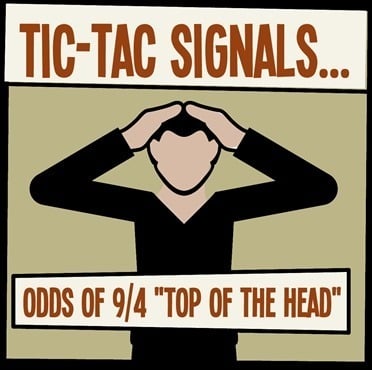Understanding Horse Racing Bookie Hand Signals: The Tic-Tac Tradition

If you've attended a horse racing event or caught a glimpse of the bookmakers at work on TV, you might have noticed their unique hand gestures. Bookies often stand on platforms, signaling with their arms in seemingly mysterious ways. This visual language, known as "Tic-tac," is an age-old system for transmitting information across the racetrack. In this guide, we’ll explore the fascinating world behind these signs, the people who perform them, and how the classic tradition functions today.
Exploring the Purpose and Origins of Tic-Tac Hand Signs
Tic-tac, a staple at UK racetracks for decades, emerged as a solution for clear and efficient communication between bookmakers. Historically, 'Tic-tac men' acted as intermediaries, relaying information about betting odds or movements in bets to colleagues or rival bookies without vocalizing it to nearby punters. Their hand signals served both as a strategic tool-ensuring their shared information remained confidential-and as a practical method to cut through the roaring crowds common at racing events.
This secret language allowed bookmakers to quickly alert one another about shifts in odds or significant bets, enabling swift adjustments and level playing fields. Besides signaling odds, Tic-tac men also assisted in brokering trades or managing large bets between different bookmakers, helping to balance the risk and excitement that underpin horse racing wagers.
The Evolution and Decline of Tic-Tac in Modern Horse Racing
Although once central to the colorful atmosphere at racetracks, Tic-tac signaling has nearly vanished. The rise of modern technology-online betting platforms, smartphones, and real-time odds updates-has greatly reduced the need for manual, visual communication. While you might encounter an occasional Tic-tac practitioner keeping the tradition alive, the spectacle of synchronized hand signals is largely a memory from racing's past.
Notable Figures in Tic-Tac History
One of the most recognizable personalities associated with Tic-tac is John McCririck-a respected racing journalist and TV figure. Known for his flamboyant style, McCririck would often demonstrate hand signals during televised broadcasts, bringing the unique flair of the racetrack straight into viewers’ homes. He once commented that Tic-tac added excitement and spectacle, recreating the vibrant energy of being trackside for audiences everywhere.
A Guide to Key Bookie Hand Signals for Odds
The Tic-tac alphabet includes a set of standard hand movements, each corresponding to a particular set of betting odds. Here’s a breakdown of some of the most recognized gestures:
- Evens: Point outward with both forefingers and alternate your arms up and down-in a seesaw motion.
- 11/10: Extend both palms open and bring your fingertips together in front of you.
- 5/4: Place your right hand atop your left wrist.
- 11/8: Slide your right hand up your left arm.

- 6/4: Position your right hand behind your left ear.
- 13/8: Start with the 6/4 gesture, then let your outstretched fingers meet in front.
- 7/4: Place your right hand on your left shoulder.
- 2/1: Bring your right hand up to your nose.
- 9/4: Rest both hands on the top of your head.

- 5/2: Bring both hands up to frame your nose.
- 11/4: Combine the 5/2 gesture with fingertips coming together afterward.
- 3/1: Hold your hands palm-down and raise both to your chin.
- 9/2: Place each hand on one shoulder.
- 5/1: Rest your right hand on your right shoulder.
- 6/1: Perform the 5/1 move and then tap the top of your head.
- 7/1: Perform the 5/1 gesture, then tap your nose.
- 8/1: Use the 5/1 gesture, then tap your chin.
- 9/1: Extend your right arm outward and place your left hand on your head.
- 10/1: Bring both clenched fists together as if they’re punching each other.

- 16/1: Do the 10/1 (punch), touch your right shoulder, then top of your head.
- 33/1: Sweep your hands across your chest.
Common Tic-Tac Slang: Bookie Lingo Decoded

Alongside the hand signs, bookies often use colorful slang to further mask their intentions or simply to add fun to the tradition. Here’s a selection of terms connected with popular odds:
| Odds | Slang Term(s) |
|---|---|
| Evens | Straight up, Scotch, Levels you devils, Major Stevens |
| 11/10 | Wrist |
| 5/4 | Tips |
| 11/8 | Up the arm |
| 6/4 | Ear'ole, Ear to rouf |
| 13/8 | Unlucky, Bits of the ear'ole |
| 7/4 | Shoulder, Neves |
| 15/8 | Double tap |
| 2/1 | Bottle, Bice |
| 9/4 | Top of the head |
| 5/2 | Face, Bice n’alf |
| 11/4 | Elef a vier |
| 3/1 | Carpet |
| 100/30 | Burlington Bertie, Scruffy and dirty |
| 7/2 | Carpet and half |
| 4/1 | Rouf |
Tic-Tac: Counting with Hand Signals
Beyond betting odds, Tic-tac men have developed hand signs to indicate horse numbers. Here’s how the numbering system works from one to ten:
- 1: Touch two fingers to your forehead.
- 2: Tap the same two fingers on your nose.
- 3: Tap your chin with your two fingers.
- 4: Flick the two fingers away from your body as if drawing a smile.
- 5: Place your left hand on your left shoulder.
- 6: Do the 5 sign, then the 1 sign.
- 7: Combine the 5 sign with the 2 sign.
- 8: Perform the 5 sign followed by the 3 sign.
- 9: Put one finger on top of your head.
- 10: Bring both clenched fists together in front of you.
The Legacy of Tic-Tac in Horse Racing
Tic-tac hand signals represent an enduring chapter in horse racing’s rich history, blending practicality with tradition and showmanship. While modern advancements have largely pushed this practice into the background, the playful artistry and clever communication of classic Tic-tac still holds a nostalgic appeal for racing enthusiasts. Many hope that even as digital technology advances, the unmistakable gestures of the bookie hand sign tradition will never be completely lost from the world of the turf.













